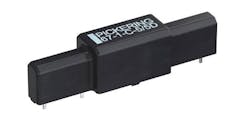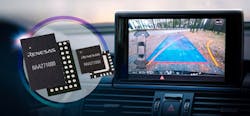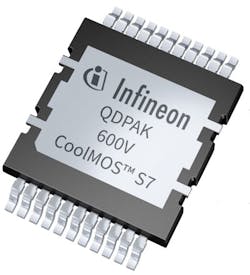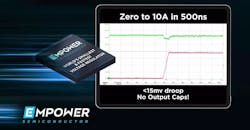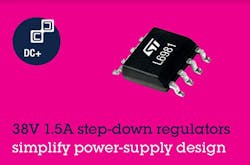>> Electronic Design Resources
.. >> Library: Article Series
.. .. >> Article Series: PowerBites
New HV SPDT Form C Reed Relays Reduce Space, Design Complexity
Pickering Electronics has introduced a new changeover 1 Form C version of its popular Series 67 high-voltage PCB relay that saves space and simplifies design. They’re designed for challenging applications, such as those where high-voltage signals need to be routed to alternate points, polarity reversing, and capacitor charge or discharge. These are often implemented using two normally open (SPST/Form A) high-voltage relays to ensure that one switch is always opened before the second switch is closed. Pickering’s 67-1-C high-voltage reed relay guarantees break-before-make operation in a single, compact part, thereby simplifying the design.
Rated at up to 5-kV standoff, 2.5-kV switching at 100 W (max), the new Series 67 changeover relays measure just 58.4 × 12.6 mm—the same size as a standard Series 67 relay—and are available with 5-, 12- or 24-V coils. The devices feature PCB connections to their switch and coil. The fully encapsulated, single-in-line relays employ tungsten-plated contacts. Optional flying leads are available for high-voltage connections.
DC-DC Controllers Feature Integrated Active EMI Filter for Compact Power Designs
A new family of synchronous dc-dc buck controllers developed by Texas Instruments can simultaneously reduce the size of power-supply solutions and lower their EMI emissions. Featuring an integrated active EMI filter (AEF) and dual-random spread-spectrum (DRSS) technology, the LM25149-Q1 and LM25149 enable engineers to cut the area of the external EMI filter in half.
Other benefits derived from the devices include the ability to lower the conducted EMI of the power design by as much as 55 dBµV across multiple frequency bands as well as achieve a combination of reduced filter size and low EMI. They’re designed primarily to meet the challenges of automotive applications but are also well-suited for any application that requires low volume, low EMI, and high reliability.
Reduce conducted EMI across the entire CISPR 25 Class 5 frequency spectrum
The LM25149-Q1 and LM25149 buck controllers help engineers create compact solutions that meet the stringent CISPR 25 Class 5 automotive EMI specifications by mitigating conducted EMI across multiple frequency bands. When operating at a switching frequency of 440 kHz, the integrated converters' AEF helps detect and reduce conducted EMI in the 150-kHz to 10-MHz band by up to 50 dBµV relative to a design with the AEF disabled, or as much as 20 dBµV when compared to a design with a typical passive filter. In both design scenarios, the DRSS technology helps mitigate EMI by an additional 5 dBµV across low- and high-frequency bands.
To further minimize EMI, both buck controllers feature frequency synchronization to an external clock, helping engineers mitigate undesired beat frequencies in applications sensitive to EMI.
Shrink the external EMI filter while minimizing solution cost
Compared to competing solutions, engineers can achieve maximum savings of nearly 50% in area and over 75% in volume of the front-end EMI filter at 440 kHz. In addition, they can enable further increases in power density with interleaved dual-phase operation and eliminate the need for an external bootstrap diode, loop compensation, and output-voltage feedback components.
Pre-production quantities of the 42-V LM25149-Q1 and LM25149 are available now in a 3.5- × -5.5-mm thermally enhanced, 24-pin very thin quad flat no-lead (VQFN) package. Pricing starts at US$1.42 and US$1.20 in 1,000-unit quantities, respectively. The LM25149-Q1EVM-2100 evaluation module is available on TI.com for US$75. TI expects both devices to be available in volume production in the fourth quarter of 2021. The company is also working on a pin-to-pin compatible 80-V version of both devices.
For additional information on the dc-dc controllers, visit www.ti.com/LM25149-Q1-pr and www.ti.com/LM25149-pr.
To learn how an integrated AEF works, read the technical article, “How to reduce EMI and shrink power-supply size with an integrated active EMI filter.”
To learn more about EMI mitigation techniques, read the white paper, “Time-Saving and Cost-Effective Innovations for EMI Reduction in Power Supplies.”
End-to-End Power + Functional-Safety Solution for ADAS Camera Systems
Renesas Electronics Corp.'s new power and functional-safety solution can reduce power loss, system cost, and design time for camera-based advanced driver-assistance systems (ADAS) systems based on their R-Car V3H system-on-chip (SoC).
The two-chip power solution consists of the RAA271050, a 42-V synchronous buck “pre-regulator,” and the RAA271000 seven-channel PMIC (power-management IC). The RAA271050 steps the vehicle’s 12-V supply down to an intermediate supply voltage of 3.3 or 5.0 V. The RAA271000 then takes the RAA271050’s output and steps it down further to produce the various supply voltages needed by R-Car V3H and its peripherals, such as LPDDR4 memory chips.
Both devices are compliant with the ISO-26262 standard, and can support system safety requirements up to ASIL D. The two-chip solution can satisfy all power and functional-safety requirements for the R-Car V3H SoC, including sequence, voltage accuracy, and load step response. It also supports all of the R-Car VH3's required safety functions for power and digital monitoring. The R-Car V3H power solution's features include:
- Programmable output voltage, sequencing, I/O configuration and safety configuration, providing flexibility to support the R-Car V3H and an expansive range of SoCs.
- Integrated 12-bit SAR ADC with up to 16 external inputs monitors internal and external signals, eliminating the need for an added system ADC.
- Dynamic voltage frequency scaling (DVFS) adjusts output voltage to minimize power consumption.
- Optional spread-spectrum clocking mitigates EMI.
- Built-in support for the R-Car V3H SoC Activation streamlines SoC self-test procedures.
A complete ADAS camera solution
The RAA271050 and RAA271000 are part of a complete ADAS front camera solution featuring the EagleCam camera module from LUPA-Electronics GmbH and Renesas’ R-Car V3H and R-Car V3M SoC devices. To help designers accelerate ADAS applications based on the R-Car V3H and R-Car V3M SoC devices, Renesas offers "The Winning Combination,” an open, turnkey reference design that delivers flexible, high-performance perception while shortening time to market and reducing the bill-of-materials (BOM) cost. More information on this design is available at https://www.renesas.com/EagleCAM.
Availability
The RAA271050 is offered in a 22-lead, 4- × 4-mm QFN package. The RAA271000 is packaged in a 60-ball FCBGA with 0.8-mm pitch. Both devices are sampling now and are expected to be fully available in July. Users can visit www.renesas.com/RAA271050 and www.renesas.com/RAA271000 for more information about the new parts. Additional details on the complete power/safety solution are available at this link.
MIT Study Reveals Potentially Disruptive Plunge in Lithium-Ion Battery Costs
A recent study conducted by MIT1,2 revealed that the cost of rechargeable lithium-ion batteries used for phones, laptops, and cars has fallen at a dramatic rate that parallels similar improvements in solar and wind energy. It also shows further steep declines could be possible. Could this mean we’re approaching the tipping point for the transition to a carbon-neutral economy?
This possibility arose from an exhaustive analysis of the studies that examined the factors driving the steady decline in Li-ion battery prices over the past 30 years. The researchers found that the cost of these batteries has dropped by 97% since they were first commercially introduced in 1991. This rate of improvement is much faster than many analysts had claimed and is comparable to that of solar photovoltaic panels, which some had considered to be an exceptional case. The new findings are reported today in the journal Energy and Environmental Science, in a paper by MIT postdoc Micah Ziegler and Associate Professor Jessika Trancik.
“These trends are so consequential for getting us to where we are right now, and also for thinking about what could happen in the future,” says Trancik, who is an associate professor in MIT’s Institute for Data, Systems and Society. While it was common knowledge that the decline in battery costs was an enabler of the recent growth in sales of electric vehicles, for example, the severity of that decline was unclear. Through this detailed analysis, she says, “we were able to confirm that yes, lithium-ion battery technologies have improved in terms of their costs, at rates that are comparable to solar-energy technology, and specifically photovoltaic modules, which are often held up as kind of the gold standard in clean energy innovation.”
In addition to helping to boost the ongoing electrification of transportation, further declines in lithium-ion battery costs also could potentially increase the batteries’ usage in stationary applications as a way of compensating for the intermittent supply of clean-energy sources such as solar and wind. Both applications could play a significant role in helping to curb the world’s emissions of climate-altering greenhouse gases. “I can't overstate the importance of these trends in clean-energy innovation for getting us to where we are right now, where it starts to look like we could see rapid electrification of vehicles and we are seeing the rapid growth of renewable-energy technologies,” says Trancik.
This is an excerpt of a longer story written by David L. Chandler, MIT News Office. You can read the complete article, posted in ED's Power Management section, by clicking here.
References
1. You can read the complete MIT study “Re-examining rates of lithium-ion battery technology improvement and cost decline” at the following link: http://doi.org/10.1039/d0ee02681f.
2. The work was supported by the Alfred P. Sloan Foundation.
600-V MOSFETs Target Static-Switching Applications
Two additions to Infineon Technologies’ CoolMOS S7 family of high-power MOSFETs are optimized for low-frequency and static-switching applications. Both the industrial-grade 10-mΩ CoolMOS S7 and the automotive-grade CoolMOS S7A devices have been designed to minimize conduction losses, provide optimal thermal behavior, and enable more compact designs.
The 10-mΩ CoolMOS S7 has a unique low on-resistance (RDS(on)) for 600-V superjunction MOSFETs, making it ideal for applications where minimizing conduction losses are critical, such as off-the-shelf solid-state relays (SSRs). In contrast, the automotive-grade CoolMOS S7A addresses system performance requirements set by solid-state circuit breakers (SSCBs) and diode paralleling/replacement for high power/performance designs in automotive applications, such as the high-voltage (HV) eFUSE, HV eDisconnect battery disconnect switch, as well as on-board chargers.
The product family is based on Infineon's CoolMOS 7 technology platform, with enhancements to support high conduction performance, energy efficiency, power density, and improved thermal resistance, all essential characteristics for static-switching and high-current applications. As a result, the 10-mΩ CoolMOS S7 and CoolMOS S7A chips have the lowest RDS(on) in the market and best-in-class RDS(on) × A × cost.
Both devices feature an innovative top-side cooled (TSC) QDPAK SMD package, which offers excellent thermal performance and a more compact form factor than THD devices, such as a TO-247. In fact, moving from a THD package to a surface-mount device can achieve a height reduction of up to 94%. When combined with the low conduction losses of the 10-mΩ CoolMOS S7 and the CoolMOS S7A, designers reduce the size of their applications' heatsinks up to 80%.
Availability
The 10-mΩ CoolMOS S7 and CoolMOS S7A devices can be ordered now in a TSC QDPAK package (HDSOP-22-1). More information is available at www.infineon.com/s7.
Voltage Regulator Achieves World’s Fastest Transient Response: 0 to 10 A in 500 ns
Empower Semiconductor's integrated voltage regulator (IVR) EP7010 power-management device has demonstrated the world’s fastest transient response time for its class, moving through a load step of 0 to 10 A in 500 ns with <15-mv droop. The device is based on Empower Semi’s patented digitally configurable EP70xx hardware platform. It completely integrates a triple-output dc-dc power supply into a single, tiny 5- × 5-mm package and requires no external components.
With its single IC package, pinout, and basic functionality, designers can create a wide range of current and output configurations that deliver up to 10X greater power density, 3X tighter accuracy during transients, and 1000X faster dynamic voltage scaling than leading competitors.
The EP70xx family displays peak efficiencies of up to 92% with a nearly flat efficiency curve through output currents of up to 10 A. The devices' rapid dynamic voltage scaling enables fast, lossless processor state changes that can save 30% or more of processor power. Thanks to the EP70xx’s tight voltage regulation, designers are able to lower their application's operating voltage range, thereby enabling an overall power savings of 10% or more, as well as the corresponding reduction in heat dissipation.
Nine devices populate the EP70xx family, with up to three regulators per device. Devices with outputs ranging from 2 to 10 A are all available in the 5- × 5-mm, or a 4- × 4-mm package, with a 0.75-mm profile. The products achieve a level of density and simplicity so high that they’re also available in bumped die form for co-packaging with digital ICs, enabling full power-management integration into a SoC.
Product samples, demo boards, and reference designs of the EP70xx family are available immediately. For additional product details, visit https://www.empowersemi.com/product-page-ivr/.
Integrated 1.5-A Synchronous Regulators Simplify High-Efficiency Power Conversion
STMicroelectronics’ L6981 synchronous step-down regulators extend its family of high-efficiency converters that help simplify power-supply design by integrating power elements, feedback circuitry, and safety features on-chip. Rated to deliver up to 1.5 A, with 90% typical efficiency at full load, the L6981 converters come in two variants optimized for light-load efficiency and noise performance.
Both variants can operate on supply voltages ranging from 3.5 to 38 V, making them well-suited for use in 24-V industrial bus-powered applications, 12- and 24-V battery-powered equipment, HVAC power supplies, decentralized intelligent nodes, smart sensors, and always-on applications. The output voltage can be adjusted from 0.85 V up to the input-voltage value using external resistors.
During low-current operation, the L6981C uses pulse skipping to maximize efficiency and extend the runtime of battery-powered devices. The regulator also minimizes electrical noise by operating permanently in pulse-width-modulation (PWM) mode at a constant switching frequency and reducing voltage ripple at light loads.
The regulators also feature high- and low-side NMOS power transistors, feedback-loop compensation, overvoltage protection, and thermal protection. In addition, soft-start circuitry limits inrush current and ensures a constant output-voltage slope. An Enable pin is provided, which permits power-up/power-down sequencing and allows a synchronizing clock signal to be applied to the L6981N low-noise converters. The L6981 family is included in ST’s 10-year longevity program that ensures long-term component supply.
The L6981 regulators are in production now, in the rugged SO8L package, from $1.00 for orders over 1,000 pieces. The STEVAL-L6981CDR evaluation board for the low-current converter and STEVAL-L6981NDR for the low-noise version are available to help designers accelerate device selection in power-supply development.
Please visit www.st.com/buckregulators for more information.
Sharpen Your Skills, Race for the Future @ Wurth's Digital Days
Electrical engineers keep their skills sharp during the global pandemic by spending some time at WE meet @ digital days, Würth Elektronik's second annual virtual trade conference. They'll also get the chance to learn about Formula E racing from two of the sport's most competitive drivers.
The educational programming at this year's Digital Days will span four days, April 26 to 29, from 9:00 a.m. to 7:00 p.m. (ET), offering a comprehensive conference program filled with practice-oriented presentations on virtually all aspects of electrical design. Each day, electronics specialists will share their knowledge on EMC, power and thermal management, wireless power, and other circuit design topics, including:
- Choose the right thermal management solution for your design
- Identify and contain noise at source using housing, grounding and PCB solutions
- Transformer Design for EMC – practical construction techniques
- How to increase efficiency in NFC/RFID systems with Magnetic shielding
- High frequency three-phase PFC solutions for high power charging stations
- Simultaneous Wireless Power Transfer with Near Field Communication
- USB Type-C Power Delivery 3.0 with PPS adapter reference design
- Hot swappable supercapacitor backup solution
- Improving the EMI performance of isolated power modules
- Unleashing GaN with High-Performance Gate Driving
- High current, high voltage: PDUs and EMC filters for vehicles
You can also visit Wurth's virtual exhibition booth, which is equipped with new product highlights and information.
But @Digital Days isn't all work. On Tuesday April 27, EV enthusiasts and auto-racing fans will have a chance to take a deep dive into Formula E racing. During "Racing for the Future,” attendees will enjoy a live presentation and Q&A session with Lucas DiGrassi and René Rast from the Formula E team Audi Sport ABT Schaeffler. This gives attendees the chance to ask the drivers themselves about the technology, driving strategies, and what it's like to participate in the world's fastest e-sport. You can register for this exclusive event by clicking here.
All presentations and events at Wurth's Digital Days will be held live and are totally free.

